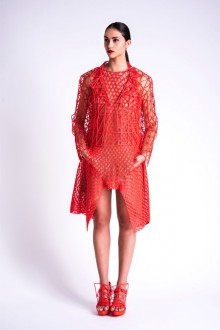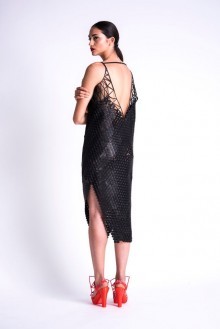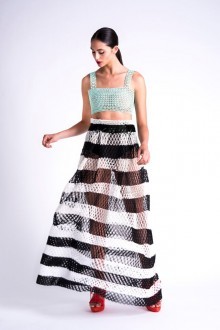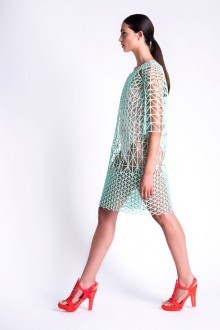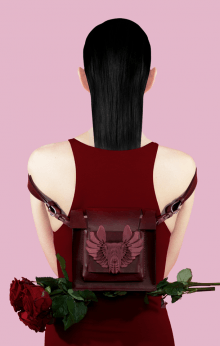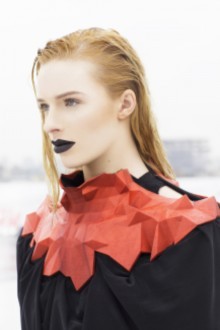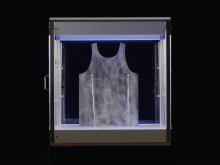3D printed fashion: Exclusive interview of Danit Peleg, Interlaced’s founder & Electroloom’s team
Posted By Claire Chabaud on Aug 25, 2015 | 0 comments
Danit Peleg. Interlaced. Electroloom.
These three names are building the foundations of the fashion industry’s future. Their uses of 3D printing has known a viral success, but beyond that, from a professional point of view it’s their vision that matters. They re-think the manufacturing process of fashion, develop a new way to foster the outbreak of the next generation fabric and create a 3D printed textile which broaden our possibilities of design. Still, they are at the early stage of their projects. So how are they going to invent the next fashion manufacturing process? What are their visions? We ask these innovators to share with us their insights on this industry. Each of them is working in different aspects of the fashion industry and will offer us a wider analysis of what is at stake !
Danit Peleg – How designers could use the 3D printing
Kristina Dimitrova – How gather all the actors of 3D printing in fashion together
Electroloom – How 3D printing will create the fabric of the future
Danit Peleg – How designers could use the 3D printing
If this name doesn’t ring a bell, you will have for sure heard of her collection 3D printed at home.
We wanted to interview Danit because she represents the creative side of this industry. In the presentation video of her project she explains her vision of a future where we would be able to travel with no luggages as all our clothes could be directly printed from our hotel room. An idea which is worth a look!
What is disruptive in the collection 3D printed at home by Danit Peleg ?
It’s not the first time that 3D printing is used in the fashion industry. But the project of Danit Peleg is the first to propose some designs, which look actually wearable for your daily life. The dresses, the tops, the jackets and the skirts have for sure a shape well designed but most of all a shape, which looks realistic for our time. This collection helps to separate 3D printing in fashion from a futuristic vision of our clothing. In this way it offers a good proof of what this technology could be used for in the terms of textile and fashion.
Also Danit Peleg succeeds to create this collection without using the best technology or material available, and most important without specific knowledge in additive manufacturing ! Her project disrupts the idea that the use of 3D printers might be exclusive.
How the 3D printed collection of Danit Peleg is going to disrupt the Fashion Industry?
Danit Peleg is the living proof that mass fashion is not a dogma. If individuals are able to print their clothes, to select their designs, it will be the beginning of mass customization in the fashion industry. Big brand worldwide might not be the industry production models in the future. This statement will call the organization of the fashion supply chain, from the design to the retail, into question. Everything could be digitalized, which would raise some interesting questions in terms of right properties.
What is her vision for the fashion industry in 2050?
“I think we will see more and more 3D printed fashion, but it will look differently than today. What I did is almost a proof of concept – it took 2000 hours to print the collection so it’s not something that can be done easily. So for this to become commonplace 2 main things need to improve: the speed of the printers, and better materials. The filaments I produced are flexible and fun, but they are not like cotton yet. I know people are working on innovative filaments and printers (for example electroloom) so I believe it’s only a matter of time until we see better printers and more wearable materials. If the technology does improve significantly, then yes, this could be the future of the fashion industry. The consequences are huge – less shipping costs, more personalization, and most importantly the democratization of design – anyone could design clothes. Just like a viral video, you could see a “viral t-shirt” that someone designed and that everyone is suddenly wearing ”
Until 2050, to start to use 3D printing in a ready-to-wear collection, Danit Peleg combines textiles and traditional fabrics for her next project…
“Among other things I’m working on a clothing line that combines printed textiles and simple fabrics. I design pleasant and attractive clothes that can be machine washed and still look super innovative.”
… And expects the development of 3D printing materials that look more alike the traditional textile
“I think we shall soon have filaments made of cotton”
What is the next step for this disruptive designer ?
” I want to continue to experiment with new materials and printers, and try to get as close as possible to real clothes using technology. I would also like to open the first computer files store and continue to inspire more and more people. “
Kristina Dimitrova – How gather all the actors of 3D printing in fashion together
Kristina is one of the 3 founders of the Interlaced show !
« INTERLACED is a meeting of creators and innovators shaping the future of fashion through technology. This day long event main goal is to connect, discuss and ultimately help shape the future of fashion through technological innovation. A journey to the not so distant future where wearables go beyond the device, where your body is a media platform and where you will be printing your wardrobe. »
We wanted to interview Kristina because Interlaced show is gathering pionneers, corporation, academia and consumers together to discuss topics as the consumer adoption of wearable tech, the fashion innovation in 3D printing, the research on-going and the implications of fashion tech on Business and Society.
What is disruptive in the Interlaced show ?
Interlaced is unique by its approach of the future fashion industry. It gathers together all the actors who are already working on the wearable technology of tomorrow. The fact that this kind of event succeed to exist is the living proof that the fashion industry is already preparing to morph. Meeting all the different actors in this show helps to understand what would be the main challenge of the design and production. Kristina explain to us that she “ saw there was a need for information as fashion and tech but people didn’t know where to look for it.” If you want to find out more about the future of fashion, #INTERLACED2015 show will take place on 3rd September, and tickets are on sale now!
How does Kristina Dimitrova imagine the fashion industry in 2050?
“Anything can happen in 30 years from now! Even though fashion hasn’t changed that much when you look at the last 30 years, I think we’re at the point where the industry has started recognizing that it can’t survive purely by talking to itself. Technology has already made fashion more transparent and accessible and I think the next step will be when these industries completely intertwine. I would love to see how the consumer perception of 3D printed clothes, shoes and accessories will shift and if people will naturally choose to invest in such products.”
She thinks that 3D printing would not only be use by high fashion but will be also use for ready-to-wear collection….
“I would like to think so, yes! We’ve already seen the first fully 3D printed fashion collection by graduate Danit Peleg, who created it in her home. It looks perfectly wearable and has balanced technology and design wonderfully. You know these technologies will have a role in fashion when you see the emerging talent playing with them. At INTERLACED 2015 we’ll have several stunning 3D printed pieces from another young talent – Alexis Walsh – as well as fashion company Heisel, the 3D printed accessories of Heart & Noble and gorgeous bags and purses by Exocet.”
… But the ready-to-wear collections could not be anymore mass produced but masscustomized !
“Yes, potentially. The great thing about 3D printing is the fact that it is complexity-free and cuostomisation-free. With traditional manufacturing, every time you add something to the design, the cost increases. That’s free with 3D printing because the machine doesn’t know what it’s doing. And when you can make something different every time without difference in the cost, customization becomes free too.”
Regarding the material of the future, it would reflect the needs of our society and be more adapted to the very own features of our body.
“The material of the future is versatile and multifuncltionnal. We live in a high-speed society and expect so much of our days, ourselves, our phones and gadgets, that it seems fashion is lacking behind. Just a new floral design doesn’t cut it any more. I suffer from anaemia, so my hands and feet are always cold (especially in the UK!), so my dream is to see everyday clothes from materials that keep you warm or cool you down when needed, like the jackets from Polychrome Lab.”
Electroloom – How 3D printing will create the fabric of the future
Electroloom is the first textile printer ! Their project, which has been successfully crowdfunded on Kickstarter offers numerous possibilities to think the use of 3D printing in the fashion industry. Electroloom represents the research and material aspect of the fashion industry. Their innovation allow us to easily understand what is at stake regarding the manufacturing process.
Why is Electroloom disruptive?
Sometimes 3D printing is not considered relevant for the textile industry due to the rigidity of 3D printing materials used, which would be too hard to wear. Electroloom by developing a 3D printing textile is bridging the gap between this two industries.
How Electroloom is going to disrupt the fashion industry ?
The impact on the manufacturing process in the fashion industry will depend of the development of the printers. If Electroloom will have the possibility to be a printer with a higher speed and able to have a high quantity, 3D printing could be a substitute to the current manufacturing process for fashion companies.
How they imagine the future in 2050 ?
“I truly do think that distributed manufacturing will become a reality. I think the global supply chain will experience an enormous amount of disintermediation. Smaller brands and companies will be able to manufacture locally, or with new technologies including ours, even on-site. We’re already seeing a little of that with small stores buying Stoll machines and producing their own knitwear on-site. I think people will be more used to the idea of designing their clothes—from simple features like color and fit, to even the entire aesthetic of the garment.”
In a first time Electroloom targets Individuals and in the future, hopes to be a reliable manufacturing solution for larger companies.
“I think in the beginning Electroloom is well-suited to work for individuals, research labs, or prototyping studios. As the technology matures and the yield improves, then it may become a true manufacturing solution for larger companies. The challenge is becoming competitive with traditional textile manufacturing. That is really difficult because it has had (arguably) thousands of years to mature, and is quite efficient and has high throughput. Hopefully we’ll get there.”
They think in the future 3D printing fabrics will be mainly about soft fabrics than the rigid fabrics we’ve been seeing in haute couture collection…
“Although it may sound counter-intuitive, I think the future is in maintaining the status quo of the feel. I don’t think soft fabrics are going anywhere. What might change is what aesthetic we like, and the overall design of what we are wearing. But I don’t see the future of fabric moving into rigid pieces that we’ve been seeing as fashion pieces on the catwalk. Although those really are a true testament to the design power of 3D printing.”
… and even if 3D printing might be disruptive for the fashion industry, it will take some time before the overall textile production changes.
“That’s difficult to say. Even if you look at 3D printing, it’s taken decades to become a consumer concept and even still has a long way to go before really disrupting mainstream manufacturing. I’d say we are definitely looking at similar timeframe. I think slow, steady maturation of our technology really will lead to a new way of looking at textile production. “
As demonstrated Karl Lagarfeld in the last Chanel fashion show with the 3D printed jacket, SLS printing has also a role to play in fashion industy…
“I think SLS and other 3D printing technologies has a place in the future of fashion. It is an amazing solution for wearables including jewelry. And there is even potential with other accessories, including shoes. Ultimately, I think there needs to be a new breakthrough to provide a solution for wearable fabrics. And that’s what we are working on. “
Conclusion – 3D printing will impact the Fashion industry on all professional levels.
So what steps do the fashion industry need to take to use 3D printing for brands and products?
- The First step concerns the design of the products.
To be able to produce a 3D printed collection, designer would have to improve their skills in CAD software. But Danit Peleg, proved us that a fashion designer willing to success will be able to create his collection.
- The Second step is the production, including the manufacturing process and the materials.
Electroloom will definitely be a pioneer in this technology and disrupts the manufacturing process.
- The Third step will be the retail.
As the project of Danit Peleg, will computer files stores pop up in a near future ? We think for sure the biggest step for fashion industry in retail would be the digitalization. For consumers not familiar with CAD software, 3D printing services, as Sculpteo, would have a key role for the printing of these digital clothes.
- The Fourth step will be to get the end consumer used to this technology.
Consumers are not well-aware of what is going on in wearable technology. Show as Interlaced are a useful mean to effectively communicate to the wider public. This awareness is key to corporations and pioneers to bring to market their products quicker.
A warm thank you to Danit Peleg, Kristina Dimitrova and Marcus, Aaron and Joseph from Electroloom who took the time to share their passion with us.


 Connect with Google
Connect with Google Connect with Facebook
Connect with Facebook
